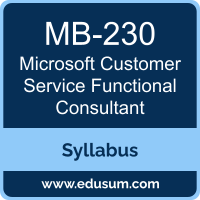 Use this quick start guide to collect all the information about Microsoft Customer Service Functional Consultant (MB-230) Certification exam. This study guide provides a list of objectives and resources that will help you prepare for items on the MB-230 Microsoft Dynamics 365 Customer Service Functional Consultant exam. The Sample Questions will help you identify the type and difficulty level of the questions and the Practice Exams will make you familiar with the format and environment of an exam. You should refer this guide carefully before attempting your actual Microsoft MCA Dynamics 365 - Customer Service Functional Consultant certification exam.
Use this quick start guide to collect all the information about Microsoft Customer Service Functional Consultant (MB-230) Certification exam. This study guide provides a list of objectives and resources that will help you prepare for items on the MB-230 Microsoft Dynamics 365 Customer Service Functional Consultant exam. The Sample Questions will help you identify the type and difficulty level of the questions and the Practice Exams will make you familiar with the format and environment of an exam. You should refer this guide carefully before attempting your actual Microsoft MCA Dynamics 365 - Customer Service Functional Consultant certification exam.
The Microsoft Customer Service Functional Consultant certification is mainly targeted to those candidates who want to build their career in Microsoft Dynamics 365 domain. The Microsoft Certified - Dynamics 365 Customer Service Functional Consultant Associate exam verifies that the candidate possesses the fundamental knowledge and proven skills in the area of Microsoft MCA Dynamics 365 - Customer Service Functional Consultant.
Microsoft Customer Service Functional Consultant Exam Summary:
| Exam Name | Microsoft Certified - Dynamics 365 Customer Service Functional Consultant Associate |
| Exam Code | MB-230 |
| Exam Price | $165 (USD) |
| Duration | 120 mins |
| Number of Questions | 40-60 |
| Passing Score | 700 / 1000 |
| Books / Training | MB-230T01-A: Microsoft Dynamics 365 Customer Service |
| Schedule Exam | Pearson VUE |
| Sample Questions | Microsoft Customer Service Functional Consultant Sample Questions |
| Practice Exam | Microsoft MB-230 Certification Practice Exam |
Microsoft MB-230 Exam Syllabus Topics:
| Topic | Details |
|---|---|
Manage cases in Customer Service (51–55%) |
|
|
Define and configure foundational Customer Service components
|
- Implement and monitor record creation and update rules
- Configure and modify the case resolution experience - Configure and manage security roles - Configure the timeline control, including records, card forms, and highlights |
|
Create and administer knowledge management
|
- Configure internal knowledge search capabilities
- Configure tables for knowledge management - Manage translated knowledge articles - Integrate and search external knowledge sources - Configure AI suggestions and Copilot-led knowledge article creation |
|
Manage collaboration
|
- Configure Microsoft Teams chat
- Configure Join a Teams call for specific users - Configure suggested contacts in Microsoft Teams, including by using AI and rules-based suggestions - Configure Teams collaboration experience |
|
Manage agents and Copilot in Service features
|
- Configure Ask a Question, including filtering content
- Configure case, timeline, and conversation summaries - Configure Draft a Response - Configure the Case Management Agent - Integrate agents with Customer Service, including plug-ins and knowledge sources |
|
Create and manage SLAs for cases
|
- Configure SLA settings
- Implement actions by using Power Automate - Apply SLAs - Create and manage SLA items including key performance indicators (KPIs), warning actions, success actions, and applicability - Configure a timer control on a form - Create SLA KPIs |
Configure representative experience and routing (25–30%) |
|
| Configure routing |
- Configure workstreams
- Configure user settings - Manage capacity profiles - Configure work classification and assignments, including rules - Configure basic routing rulesets - Configure skills-based routing and Skills Finder - Configure queues - Configure routing for records |
| Configure productivity tools |
- Configure scripts, including slugs
- Create macros |
|
Configure the Copilot Service workspace
|
- Configure session templates
- Create experience profiles - Configure the Agent Inbox, including creating custom views - Configure application tab templates |
Extend Customer Service (15–20%) |
|
|
Configure the data model and UI components
|
- Create and configure forms
- Create and configure views - Configure model-driven app components - Create and configure columns - Configure alerts and in-app notifications - Create or modify a table - Configure relationships - Configure Dataverse search - Create and manage email templates |
|
Capture customer feedback by using Customer Voice
|
- Trigger distribution of a survey
- Personalize a survey - Populate survey results against cases and conversations |
To ensure success in Microsoft MCA Dynamics 365 - Customer Service Functional Consultant certification exam, we recommend authorized training course, practice test and hands-on experience to prepare for Microsoft Dynamics 365 Customer Service Functional Consultant (MB-230) exam.
